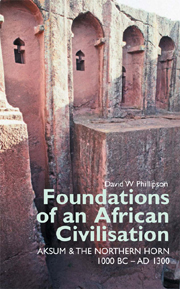Book contents
- Frontmatter
- Contents
- List of illustrations
- 1 General introduction
- Part One BEFORE AKSUM
- Part Two THE KINGDOM OF AKSUM
- 4 Aksumite civilisation: an introductory summary
- 5 Aksumite languages and literacy
- 6 Some written sources relating to Aksumite civilisation
- 7 The emergence and expansion of the Aksumite state
- 8 Aksumite kingship and politics
- 9 Aksumite religion
- 10 Cultivation and herding, food and drink
- 11 Urbanism, architecture and non-funerary monuments
- 12 Aksumite burials
- 13 Aksumite technology and material culture
- 14 Aksumite coinage
- 15 Foreign contacts of the Aksumite state
- 16 Decline and transformation of the Aksumite state
- Part Three AFTER AKSUM
- Bibliographic references
- Index
- EASTERN AFRICAN STUDIES
13 - Aksumite technology and material culture
from Part Two - THE KINGDOM OF AKSUM
Published online by Cambridge University Press: 05 December 2015
- Frontmatter
- Contents
- List of illustrations
- 1 General introduction
- Part One BEFORE AKSUM
- Part Two THE KINGDOM OF AKSUM
- 4 Aksumite civilisation: an introductory summary
- 5 Aksumite languages and literacy
- 6 Some written sources relating to Aksumite civilisation
- 7 The emergence and expansion of the Aksumite state
- 8 Aksumite kingship and politics
- 9 Aksumite religion
- 10 Cultivation and herding, food and drink
- 11 Urbanism, architecture and non-funerary monuments
- 12 Aksumite burials
- 13 Aksumite technology and material culture
- 14 Aksumite coinage
- 15 Foreign contacts of the Aksumite state
- 16 Decline and transformation of the Aksumite state
- Part Three AFTER AKSUM
- Bibliographic references
- Index
- EASTERN AFRICAN STUDIES
Summary
This chapter does not attempt to provide a comprehensive account of Aksumite material culture. It concentrates on technology and affinities rather than on typology. For detailed descriptions and illustrations of artefacts, the reader is referred to the principal excavation reports included in the bibliography.
Aksumite material culture displays many remarkable features due to its blending of indigenous elements with those derived from external contacts, notably with the Nile Valley, southern Arabia and the circum-Mediterranean region. In the past, there has been a tendency for the external to be emphasised at the expense of the local (cf. Chapter 1). Correction of this imbalance being one of the aims of the present book, this chapter seeks to evaluate the extent to which different elements of Aksumite material culture and technology may be traced either to local antecedents or to indigenous innovation. It is convenient to arrange the treatment under the principal raw materials that were exploited, despite the cross-referencing that such an approach inevitably involves.
Pottery
So far as is currently known, all pottery produced within Aksumite territory was hand-made – without use of the wheel – employing technology that had been locally established long previously (Fig. 59). Such wheel-thrown pottery as has been recovered from Aksumite archaeological contexts appears to have been imported; some of its forms were, however, imitated by local potters using their own technology. While some accounts place considerable emphasis on the imported pottery, locally-produced wares invariably represent a very high proportion of the total ceramic assemblages.
- Type
- Chapter
- Information
- Foundations of an African CivilisationAksum and the northern Horn, 1000 BC - AD 1300, pp. 159 - 180Publisher: Boydell & BrewerPrint publication year: 2012

